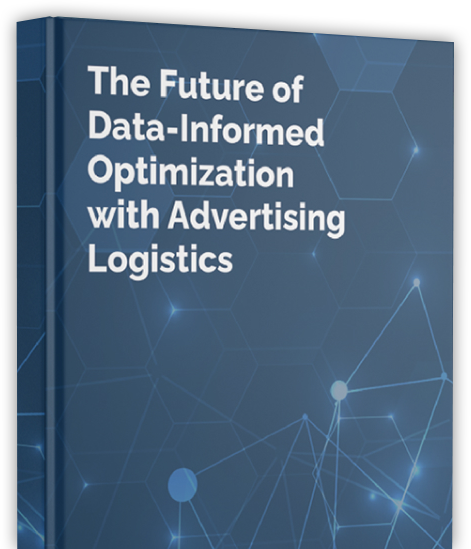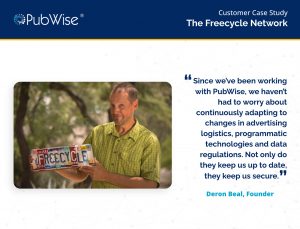Description
In this week’s podcast, we put PubMatic’s chief commercial officer Jeffrey Hirsch on the spot about issues related to creating a more open and robust marketplace for stakeholders across the programmatic ecosystem. Listen as he and PubWise CTO Stephen Johnston share timely insights about observability, supply and demand path optimization, data interchange standards and how to identify where value is being created and trust is being earned across the rapidly-evolving digital advertising supply chain.
Transcript
Tony Winders: Hello, and welcome to another edition of On the SPOT. My name is Tony Winders. And today we’ll be putting PubMatic Chief Commercial Officer Jeffrey Hirsch On the SPOT about automation solutions for an open digital media industry. Jeff, welcome to the show.
Jeffrey Hirsch: Thanks, Tony. Good to be here.
Tony Winders: As always, joining us is PubWise Founder and CTO, Stephen Johnston. Stephen, good to have you back.
Stephen Johnston: Thanks, Tony.
Tony Winders: I want to put Jeff On the SPOT about what it means to be the premier automation solutions company for an open digital media industry. That’s a PubMatic moniker and I’m really eager to hear what that means in your words, Jeff.
Jeffrey Hirsch: Sure. And thanks for putting me On the SPOT. You know, when we think about the position that we’re in, and the opportunity that we have, first and foremost, we very much believe in the open internet. Our mission statement is actually about supporting the endless content and content creators that are out there and providing them with the funds to be able to continue developing that content, and to making it available to all those who want to consume it. And that’s what the open Internet is to us from a consumer point of view. From a business point of view, the open internet is accessibility to advertisers and to publishers to do business in a way where they’re not constrained by how one company might do business or how one company might be managing their consumer base. But creating a robust ecosystem, if you will, of supply and demand that allows advertisers to have the maximum opportunity to get the ROI they’re looking for and publishers to have the opportunity to take advantage of revenue out there to continue to support content development.
Tony Winders: And then the automation portion of that?
Jeffrey Hirsch: The way that we look at it is that all advertising will be digital and all digital will become programmatic. So programmatic really, in the simplest sense is the automated means to buy and sell media. And we believe that that’s absolutely the future across the board. So we spend a lot of time looking at how to influence the parts of the chain that we can influence, obviously being PubMatic, we spent the early parts of our company developing technology solutions for publishers. Over the last few years, however, we have also begun doing the same on the buy side. And about four years ago, we realized that in order to provide publishers with the maximum opportunity for their revenue, we needed to have more engagement with the buy side and bring the two together. So we started working with agencies and marketers under the umbrella of supply path optimization, SPO. And what this meant is we were going to these buyers and asking them the questions, what problems do you need to solve to be able to automate your buying media at scale, efficiently and effectively? And that’s essentially programmatic. And in doing so we were able to work very closely with a lot of buyers, to bring to them perhaps bespoke technology solutions, additional transparency data, etcetera, to enable them to do more business programmatically. And that tied in very well with the things that we’ve been doing on the publisher side. For many, many years.
Tony Winders: It sounds a lot like the end-to-end programmatic supply chain conversations that Stephen and I have been having. Stephen, what does all that bring up for you?
Stephen Johnston: We’ve been seeing those similar trends and our questions have largely been, what’s the difference between transparency and we’ve been using more technical term observability to ask questions about not just providing data, which may be transparent, but what can we provide that actually allows people, the publisher or the buy side to actually affect change? I think that’s something of an SEO question, or a demand path question. But it’s also, what can the publisher do that actually affects that? So in other words, how do they win the supply path optimization challenge? And I think we’re going back to the buy side and asking the same thing, how do you win the demand path? We’ve got some demand path optimization technology that’s activated through prebid, so what are the levers that each of these sides can pull, not just the automation between them? That’s where we’ve been asking a lot of our product questions.
Jeffrey Hirsch: That’s a good point. I think transparency has come about as a keyword, mostly because there has been a lack of trust in the programmatic ecosystem. So the word transparency obviously has a connotation of being able to see what’s going on. And I think that’s an important place to be and when you get to observability, I think that sounds like the next step which is, now what are you learning from that transparency? And I think the next step is action, right? How do you now activate what you’ve learned? And to do what you said, Stephen is being able to help both sides understand how to get the most value.
Stephen Johnston: Closing that loop back into audience acquisition optimization, why aren’t you being selected for a campaign where you don’t have X, Y, or Z in the audience mix? How do you change that? We’ve done so much work just to provide publishers essentially more net revenue data, and largely calling it buyer data. But there’s still a large lack of what decisions are being made around that and why. We’re looking at things like supply chain and what can you intuit or get out of that data to provide that back. Almost reversing the prediction and predicting why you’re not being selected.
Jeffrey Hirsch: With programmatic, you do lose some communication, I think some one to one communication and the days of the IO, the advertiser could very clearly state, here’s what I want to buy and why. And the publisher could respond to it. I think in programmatic, you have to find a way to create that same conversation. And in as automated a way as possible the publisher knows what to deliver to solve for the advertisers needs and vice versa.
Stephen Johnston: And there’s less discreteness, right, you don’t have a stack of IOs and a stack of prescriptive indications of what you need to achieve in order to hit metrics. You’ve got this amorphous, classic cloud of buyers that are in and out of the transactions in what can feel kind of random from both sides perspective.
Jeffrey Hirsch: What you’re talking about is a lot of the reason why PMPs have grown so rapidly. I would have thought that having an open market would have been more practical. I mean, it’s more efficient. So you can buy at scale, and you can do so efficiently. But I think buyers lost trust, they didn’t know enough about where their ads were being placed, what the content looked like, all those different factors. So they’re weighing in now, by using PMPs to get to that same level of insight and communication that the open market doesn’t give them. And it’s kind of a shame to have that happen because we’ve lost that efficiency and scale.
Stephen Johnston: So some reduction in scale and the upside is growth in specificity. I’ve seen things like the IAB recommending data interchange standards and things like that. Are you involved in that at all?
Jeffrey Hirsch: Yeah, we’re involved and there’s a number of studies going on globally around transparent supply chains. One of the difficulties is the definitions. Every company’s approaching things from a little bit of a different point of view. So you have different definitions of data. Also, as you’re looking at the supply chain, there was a study done a couple years ago, by PwC, in the UK, and they were not able to track down 10%. One of the reasons could be that they’re not taking into consideration things that we all know about. So IVT, discrepancies, charges for using a wrapper, there’s just a lot of fees that go into the chain, that you may not see in a bid stream and you may not see if you’re only looking at the interaction between the DSP and the SSP. And then also with all of these studies now, what we’re a little concerned about is that if there are studies going on in multiple regions, and they’re each being done differently, isn’t that going to actually end up creating more confusion than less? Because they’re all going to come up with different results because of the methodologies.
Stephen Johnston: Sure. Yeah. It’s the classic like, you’re measuring something, but are you measuring what you think you’re measuring? If you can’t answer that, then you’re still lost. It’s great to get some sort of directionality out of it. But I think, like you’re saying, if you don’t really know if you’re measuring the same things, you can maybe point out that there’s something there, but people will sometimes read way too much into that.
Jeffrey Hirsch: Yeah, and I think standards can help a lot. It’s the best we can do right now, I was involved in a lot of the standards around what used to be called behavioral targeting. It’s a bad word now, of course, and it did help quite a bit in understanding what kind of data was being used, how it was categorized, privacy issues around it, and all those things. So it helped, it didn’t solve the complete problem, but it was definitely a big step. And I do think we need more of that, maybe IAB will be able to help us get there, I certainly hope so.
Stephen Johnston: I think you have an interesting perspective now with regulation catching up with some of that work you did back then around behavioral targeting. It’s looping back around to regulating and legislating some of that versus just open awareness and agreement amongst people in the consortium.
Jeffrey Hirsch: Yeah. I mean, that’s the risk of not coming together as an industry and agreeing on the standards and how to do things is having the government step in. I think that’s actually happening in Australia right now, is that they’re looking at helping the digital advertising business actually set rates for different services. And it’s hard to imagine someone that’s not in the industry really understanding enough to be able to do that.
Stephen Johnston: I see some of the same kinds of things going on around addressability versus measurement conversation where we get into sort of predictive audiences and these kinds of things. When we talk about pseudo anonymous, are we really talking about the same thing? When we talk about fuzzed data where you can’t get back to the user, there’s still a lot of conversations where people are using similar terms, but maybe they don’t mean the same thing. There’s definitely a danger, I think of ending up in the same situation where if we don’t do the work, someone else will do it for us.
Jeffrey Hirsch: Yeah. I think that’s true. The use of data, just like we were talking about with anything in programmatic, there are so many different ways to get data, to have consumers agree to it being used, or unfortunately, sometimes not to be able to then activate that, that there’s still a lot of confusion around it for sure. And that’s going to always affect how much we can do when we’re trying to target an audience. And the same thing will occur with attribution. So if we don’t know what we’re doing in the front, it’s going to be hard to know what’s happening in the back.
Tony Winders: I’d like to put you both On the SPOT about something that you’re speaking about in general, but PubWise is preparing to introduce the concept of advertising logistics, as a concept and an ebook. Stephen briefly explain to Jeff what your view on that is and I’d like to see what Jeff thinks about that as a concept for our industry and a construct for moving both SPO and DPO forward.
Stephen Johnston: What we were talking about a little bit earlier, making decisioning around signals that are available, and a lot of our work has been on looking at the things that aren’t what we call intrinsic to the ad and size, sight and those sorts of things, the extrinsic data that you add along the way, the things that you discover about their request and the logistic context of the ad right now is largely an Schain kind of question. I think as we get further down the road with identities, identity is a proponent of that, alternatives to cookies, contextual is kind of a proponent of that you might consider that intrinsic. And I think the opportunity becomes to really begin to measure contribution. And so the conversation in the past has been, simplify the supply chain, simplify your Schain, simplify participants, we’re really looking forward to the opportunity to be able to measure contribution, as things go through. I think the industry has a little ways to go and that’s why I’m asking questions about data interchange standards, things like that. We want to look at who’s contributing to the value of the ad along the way, we can measure or predict a value based on the intrinsic data. But when we can start to make selections about who participates and who adds value, I think that’s a really interesting position for the publisher.
Jeffrey Hirsch: You know, if you’re talking about having a set of signals, and being able to understand the value of each signal, it almost doesn’t matter, forgetting about privacy issues for what I’m saying, it almost doesn’t matter what those signals are, right? If you can take signals and understand the value of each one, and then match that to what the advertiser is trying to achieve, where they’re seeing their ROI. You can keep adding and subtracting those signals over time and do A/B testing and understand the value of each as you progress. And then I think the important thing is, as you said, let the publisher know, here’s the signals that we know are of value in this campaign. So if you can help us enhance those signals, we know we’re going to get better results. And with that, we’re going to spend more with you.
Stephen Johnston: You can sort of rail about first party data and do the work to get all these things that publishers have to do. But if you put them back in the black box, or they don’t know what it did, then I think we lose an opportunity to get that type of publisher who wants to do that work really plugged into that process, because they’ve been habituated to go with a lot of these sorts of we’re going to hand over a monetization to an external company and hope. And I know that’s not true for everybody but there is a fat middle that I think falls into that at times.
Jeffrey Hirsch: One of the things that may be hindering that is if the buyer provides too much information to the publishers on how to provide these signals then the publisher is going to have more power in the negotiation. So if the buyer is trying to hold on to the power that they naturally have by having the spend, and not let anyone infringe on that then they’re going to want to do things on their side and not share as much so that they control the relationships.
Stephen Johnston: Sure. And that was certainly facilitated greatly by third party cookies versus needing to possibly in the future rely more on a publisher to agree to share data.
Jeffrey Hirsch: So what you’re saying in that regard is that there’s a new dawn for publishers based on first party data and the ability to leverage that in the cookieless environment, right?
Stephen Johnston: As they’re given control of it. And it’s not just another land grab in some DMP owned by a DSP.
Jeffrey Hirsch: Yeah, it makes sense. Over time in this industry, the pendulum keeps swinging back and forth. And you’re always hoping it lands in the middle of it, and it never does. It radically goes to each side.
Stephen Johnston: We see that all across, I would say, to some degree in anything technical as just a long history of rushing to one end of the boat and weighing that side down then rushing to the other. We see it in server to server and the different paradigms for how we deliver technology.
Tony Winders: Well we’re coming up on our time. Jeff or Stephen, anything else you’d like to address before we go?
Jeffrey Hirsch: No, I think that was a great conversation. I certainly applaud the concept of finding a way to really share more with both sides to create a better result. And it clearly can make a big difference. I think that power dynamics aside, that’s the right direction for all of us to be going
Stephen Johnston: Well, I appreciate the conversation, Jeff.
Tony Winders: Very good. This has been On the SPOT. I’d like to thank my co host, PubWise Founder and CTO Stephen Johnston and our very special guest Jeffrey Hirsch, the Chief Commercial Officer at PubMatic. And I’d also like to thank our listeners and invite you to join us for another episode of On the Spot very soon. Thanks, everyone.





